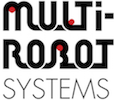 |
Half-day workshop at 2016 IEEE ICRA, Friday May 20th from 1:30pm to 6pm
Stockholm Waterfront Congress Center (Sweden)
|
|
|
|
|
Fielded Multi-robot Systems Operating on Land, Sea, and Air Workshop at 2016 IEEE ICRA supported by the Technical Committee on Multi-Robot Systems.
Venue: Stockholm Waterfront Center, Room: Room 24 Date and Time: Friday May 20th 2016, from 1:30pm to 6pm Scope This workshop aims at providing an overview of current research related to real world deployment of heterogeneous multirobot systems. Many operational situations can indeed benefit from the deployment of a team of robots, in which the robots may have different motion, sensing and decision abilities, or complementary operational payloads. The objective of the workshop is to present the most recent results, obtained by the main research groups active in the field, and to highlight what are the main challenges to be faced to achieve effective deployment of heterogeneous multirobot systems. The objective of the workshop is first to provide an overview of the main current research activities on teams of heterogeneous robots, focusing in particular in fielded developments. Second, it will be the opportunity to debate a series of questions related to such systems:
Program
Igor Gilitschenski, Autonomous Systems Lab (ETH Zurich, Switzerland) As the number of different robotic applications increases, it becomes more and more common to involve different types of robots simultaneously. This results in several advantages for perception systems compared to a setting that involves only one single robot because richer information may become available. In order to benefit from these advantages, several challenges need to be addressed. First, when using more than one robot, it becomes necessary to fuse information obtained from individual robots. Second, use of different types of robotic platforms often requires consideration of a broader variety of sensor types with different sensing modalities, and thus, different types of measurements. In this talk, we will discuss how these challenges can be addressed in practical applications, particularly for estimation and mapping scenarios. This discussion will cover simultaneous consideration of different levels of uncertainties, a sound representation of underlying domains, and cooperation of multiple heterogeneous agents in large -scale map building. The presented methodology will involve directional and robust statistics, and use of optimization based estimation approaches.
Robotic systems are finding more and more their way to the field. One application field where they have proven their benefits is in the field of crisis management and disaster relief. Of course, when deploying multiple robotic systems into a crisis area, one must consider carefully the interoperability aspects between these fielded systems. Indeed, standardization is still no easy concept in the world of robotics and certainly in the case of multi-domain crisis, it is easy to predict that there may and will be important interoperability concerns between light UAS, medium-size UGVs and potentially heavy UMS, all with their own control and communication architectures and protocols. The EU ICARUS project has investigated these interoperability issues and has proposed potential solutions in the form of standardized interfaces for multi-domain systems. These solutions have been extensively validated using 3 separate field tests. A shipwreck accident was simulated near the Lisbon harbor. The Portuguese Navy intervened to rescue the victims in the water, helped by the ICARUS UAS and UMS. An earthquake was simulated in Belgium. The Belgian First Aid and Support Team intervened to rescue the survivors, helped by the ICARUS UAS and UGVs. Important during all these exercises was the complete integration of the unmanned tools in the toolkit of the rescue workers and into their standard operating procedures. As a third validation test, the ICARUS team participated to the euRathlon2015 trial in Italy, simulating a multi-domain accident requiring the intervention of UAS, UMS and UGVs at the same time. In this presentation, the speaker will show how the ICARUS multi-domain interoperability concept was applied in these three use cases of fielded multi-robot systems, operating on land, air and sea.
Luiz Chaimowicz, Universidade Federal de Minas Gerais (Brazil)
Charles Lesire-Cabaniols, Onera (France) Surveillance missions, for infrastructure security or after disasters, are becoming a serious application for robotics. They demand high autonomy skills as the environment may be partially known, highly dynamic, or even hazardous. In addition to navigation skills, deliberation and cooperation are then mandatory to manage teams of robots in such missions. In this presentation, I will present the planning and execution architecture we have developed and deployed in several surveillance missions: (1) patrolling with ground and air vehicles with limited communications, (2) wreck localization with submarine, surface and air vehicles, and (3) adhoc network deployment for nuclear plant surveillance. (1) and (2) have been conducted during the Action project funded by the French Armaments Procurement Agency (DGA) (3) has been conducted in the FrenchGerman ANCHORS project funded by the French National Research Agency (ANR) and the German Federal Ministry of Education and Research (BMBF).
Vincenzo Lippiello Università di Napoli Federico II (Italy)
Patrick Doherty, Linköpings universitet (Sweden) In this talk, I will discuss a generic framework for collaboration among humans and multiple heterogeneous robotic systems based on the use of a formal characterization of delegation as a speech act. The fielded system consists of a complex set of integrated software modules that include a delegation manager, a task specification language, a task planner, multi-agent scan trajectory generation and region partitioning modules, and an infrastructure used to distributively instantiate any number of robotic systems and user interfaces in a collaborative team. The application to be demonstrated is focused on 3D reconstruction in alpine environments that provides situation awareness to alpine rescue teams. Two complex UAV systems, a fixed-wing and rotor-based system, have been used in the field experiments to be discussed. A fully autonomous collaborative mission demonstrated in the Italian Alps will be the basis for the talk.
Organized by
|


